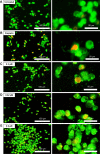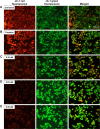10 H-3,6-Diazaphenothiazine induces G2/M phase cell cycle arrest and caspase-dependent apoptosis and inhibits cell invasion of A2780 ovarian carcinoma cells through the regulation of NF-κB and (BIRC6-XIAP) complexes
- PMID: 29123378
- PMCID: PMC5661483
- DOI: 10.2147/DDDT.S144415
10 H-3,6-Diazaphenothiazine induces G2/M phase cell cycle arrest and caspase-dependent apoptosis and inhibits cell invasion of A2780 ovarian carcinoma cells through the regulation of NF-κB and (BIRC6-XIAP) complexes
Abstract
The asymptomatic properties and high treatment resistance of ovarian cancer result in poor treatment outcomes and high mortality rates. Although the fundamental chemotherapy provides promising anticancer activities, it is associated with severe side effects. The derivative of phenothiazine, namely, 10H-3,6-diazaphenothiazine (PTZ), was synthesized and reported with ideal anticancer effects in a previous paper. In this study, detailed anticancer properties of PTZ was examined on A2780 ovarian cancer cells by investigating the cytotoxicity profiles, mechanism of apoptosis, and cell invasion. Research outcomes revealed PTZ-induced dose-dependent inhibition on A2780 cancer cells (IC50 =0.62 µM), with significant less cytotoxicity toward HEK293 normal kidney cells and H9C2 normal heart cells. Generation of reactive oxygen species (ROS) and polarization of mitochondrial membrane potential (ΔΨm) suggests PTZ-induced cell death through oxidative damage. The RT2 Profiler PCR Array on apoptosis pathway demonstrated PTZ-induced apoptosis via intrinsic (mitochondria-dependent) and extrinsic (cell death receptor-dependent) pathway. Inhibition of NF-κB and subsequent inhibition of (BIRC6-XIAP) complex activities reduced the invasion rate of A2780 cancer cells penetrating through the Matrigel™ Invasion Chamber. Lastly, the cell cycle analysis hypothesizes that the compound is cytostatic and significantly arrests cell proliferation at G2/M phase. Hence, the exploration of the underlying anticancer mechanism of PTZ suggested its usage as promising chemotherapeutic agent.
Keywords: anticancer; cancer cell invasion; mitochondrial function disruption; ovarian cancer; oxidative damage; programmed cell death.
Conflict of interest statement
Disclosure The authors report no conflicts of interest in this work.
Figures












Similar articles
-
10H-3,6-Diazaphenothiazine-Induced, Caspases-Mediated Mitochondrial-Dependent Apoptosis on HepG2 Hepatocellular Carcinoma Cells and Suppressed Cancer Cells Invasion via Inhibiting Mitochondrial Thioredoxin Reductase Enzymatic Activities.J Environ Pathol Toxicol Oncol. 2019;38(4):297-311. doi: 10.1615/JEnvironPatholToxicolOncol.2019030482. J Environ Pathol Toxicol Oncol. 2019. PMID: 32464002
-
Methyl lucidone induces apoptosis and G2/M phase arrest via the PI3K/Akt/NF-κB pathway in ovarian cancer cells.Pharm Biol. 2020 Dec;58(1):51-59. doi: 10.1080/13880209.2019.1701044. Pharm Biol. 2020. PMID: 31875458 Free PMC article.
-
Bithionol inhibits ovarian cancer cell growth in vitro - studies on mechanism(s) of action.BMC Cancer. 2014 Feb 4;14:61. doi: 10.1186/1471-2407-14-61. BMC Cancer. 2014. PMID: 24495391 Free PMC article.
-
Molecular chemotherapeutic potential of butein: A concise review.Food Chem Toxicol. 2018 Feb;112:1-10. doi: 10.1016/j.fct.2017.12.028. Epub 2017 Dec 16. Food Chem Toxicol. 2018. PMID: 29258953 Review.
-
Investigating the Anticancer Potential of Biochanin A in KB Oral Cancer Cells Through the NFκB Pathway.Cell Biochem Funct. 2024 Sep;42(7):e4130. doi: 10.1002/cbf.4130. Cell Biochem Funct. 2024. PMID: 39364853 Review.
Cited by
-
Human Serum Albumin and Human Serum Albumin Nanoparticles as Carriers of 10-(2'-Pyrimidyl)-3,6-diazaphenothiazine: In Vitro Spectroscopic Studies.Molecules. 2025 Jan 15;30(2):315. doi: 10.3390/molecules30020315. Molecules. 2025. PMID: 39860185 Free PMC article.
-
DNA/Protein Binding and Apoptotic-Induced Anticancer Property of a First Time Reported Quercetin-Iron(III) Complex Having a Secondary Anionic Residue: A Combined Experimental and Theoretical Approach.ACS Omega. 2022 Dec 20;8(1):636-647. doi: 10.1021/acsomega.2c05790. eCollection 2023 Jan 10. ACS Omega. 2022. PMID: 36643564 Free PMC article.
-
Convenient and efficient synthesis of novel 11H-benzo[5,6][1,4]thiazino[3,4-a]isoindol-11-ones derived from 2-bromo-(2/3-substitutedphenyl)-1H-indene-1,3(2H)-diones.RSC Adv. 2019 Apr 25;9(23):12784-12792. doi: 10.1039/c9ra02403d. eCollection 2019 Apr 25. RSC Adv. 2019. PMID: 35557558 Free PMC article.
-
Novel 3-Methyl-1,6-Diazaphenothiazine as an Anticancer Agent-Synthesis, Structure, and In Vitro Anticancer Evaluation.Molecules. 2025 Jun 27;30(13):2779. doi: 10.3390/molecules30132779. Molecules. 2025. PMID: 40649293 Free PMC article.
-
Synthesis and Structural Characterization of Novel Dimers of Dipyridothiazine as Promising Antiproliferative Agents.Molecules. 2023 Nov 19;28(22):7662. doi: 10.3390/molecules28227662. Molecules. 2023. PMID: 38005384 Free PMC article.
References
-
- Torre L, Siegel R, Jemal A. Global Cancer Facts and Figures. 3rd ed. Atlanta, GA, USA: American Cancer Society; 2015.
-
- Lee S, Whang I, Wan Q, et al. Profiles of teleost DNA fragmentation factor alpha and beta from rock bream (Oplegnathus fasciatus): molecular characterization and genomic structure and gene expression in immune stress. Genes Genom. 2016;38:193–204.
-
- Baghbani F, Moztarzadeh F. Bypassing multidrug resistant ovarian cancer using ultrasound responsive doxorubicin/curcumin co-deliver alginate nanodroplets. Col Sur B Biointerfaces. 2017;153:132–140. - PubMed
-
- Rzepecka IK, Szafron LM, Stys A, et al. Prognosis of patients with BRCA1-associated ovarian carcinomas depends on TP53 accumulation status in tumor cells. Gynecol Oncol. 2017;144:369–376. - PubMed
MeSH terms
Substances
LinkOut - more resources
Full Text Sources
Other Literature Sources
Medical

